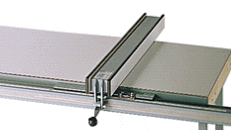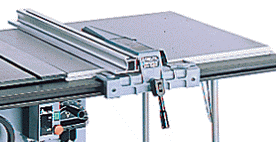The fence section can be adjusted
up or down a small amount to give a normal saw-dust relief at the bottom edge or dropped
flush to the table to keep laminates from getting under the fence and binding the cut.
The Unifence has more adjustments
in the T-square head for alignment. This is what makes the Unifence one of the easiest to
align, the Biesemeyer is fairly easy as well but not as easy as the Unifence.
The Unifence has only one reference
face. If a rip needed to be made on the left of the blade the fence extrusion and
attachment bolts would need to be removed and replaced to the right side of the T-square
head. This can be done in a matter of seconds but the Biesemeyer has two faces and avoids
the issue altogether.
The Unifence is easy to micro
adjust if the proper unlocked tension is used. By using side pressure from the thumb the
fence can be moved to accurately position the fence in very small increments. The
Biesemeyer could also be micro adjusted but to do it as well I think it would be a two
handed operation due to its non-parallel when unlocked issue.
The fence can be adjusted so that
it has minimal out-of-parallel alignment when unlocked and moved across the saw.
The Unifence is one of the easiest
fence systems to install.
The locking device on the Unisaw is
a steel on hard anodized wear surface. If too much pressure is used to lock the fence down
accelerated wear will occur on the interior of the rail.
The Unifence is a little smaller
and lighter, this makes it a little easier to take on and off of the saw when needed.
If the Unifence fence section
becomes damaged it would be costly to replace, about 30% the cost of an entire system;
this is of course a rip-off!

